3 conversion elements and how to prepare them: title, lead form, CTA button
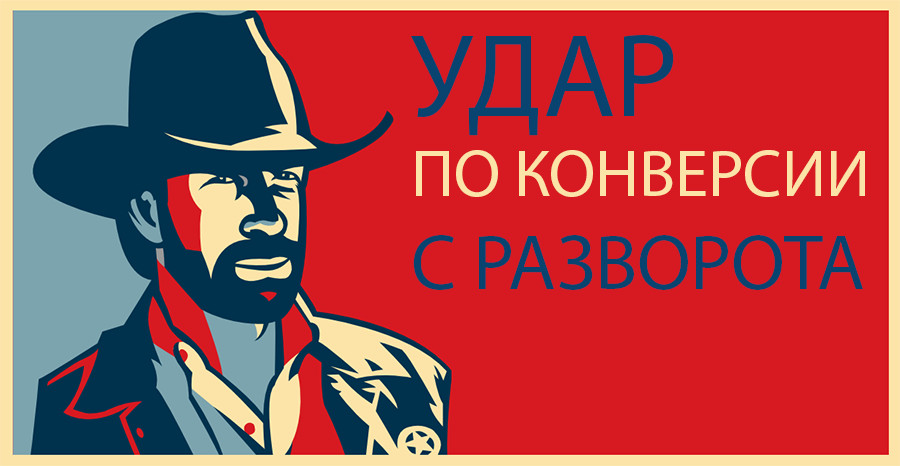
Oh, how many copies are broken in disputes around fonts, header size, number of fields in the application form, is it necessary to put the CTA (call to action) button on the first screen and what color it should be.
We do not question the importance of design and usability, while continuing to convince visitors to the landing pages. Without a strong copywriting, any visual will go "dog's waste", even if there is Artemy Lebedev.
')
In this article you will learn what to write in the title, application form and the call-to-action button. Simple, clear and convincing. Plus, we show the hacker technique how to make the conversion elements as efficient as possible.
Headline
Let's start with an illustrative anti-example, forgive us the authors of this “masterpiece”.

Go guess what these people are selling. Only the keen eye of a connoisseur will recognize the silicone profile in the picture. In this regard, the first principle of the title is clarity. A visitor in a few seconds "scans" a page with 2 questions in his head:
Did I get there?
What is the benefit here?
We do not take into account the target entry, when the user knows the company and is ready for a thoughtful analysis of the information. In 99% of cases, this is a transition from an ad, in the process of “surfing” a heap of offers. And if something is not clear - good bye.
The next point is concreteness.
For example:

Here there is already clarity: I went to the address, to the site of the construction company. At the same time there is no concreteness - “How and where we build, what is the advantage of the proposal”
"Construction of houses and cottages" - as a sign on the store. As a potential client, I have a question: “So what?” Another 99 companies in the city are doing the same. How the hell should I choose?
More successful option:
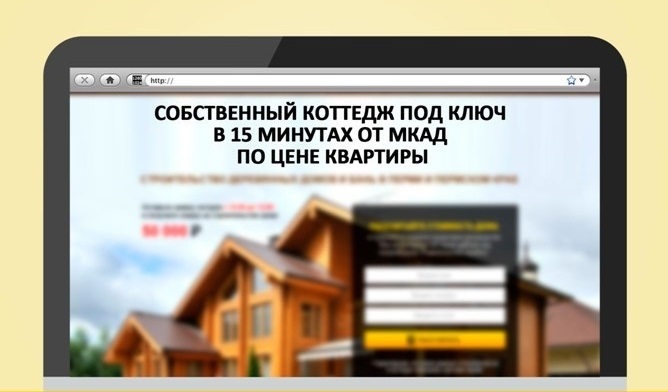
Here I already understand exactly what they are offering me: location and approximate cost + personalization - not just “House construction”, but “Own cottage”. Feel the difference?
The third principle of the selling heading is profit. It reinforces the specifics "in this company I will get such and such a result."
For example:

Everything is good, but something is missing. The last element is addressing or personalization, when the title is addressed to the user. Not “Building houses”, but “Build your house”. Not "Setting Yandex Direct", and "Configure Yandex Direct."
In our opinion, this moment is best closed by the 4U headings:
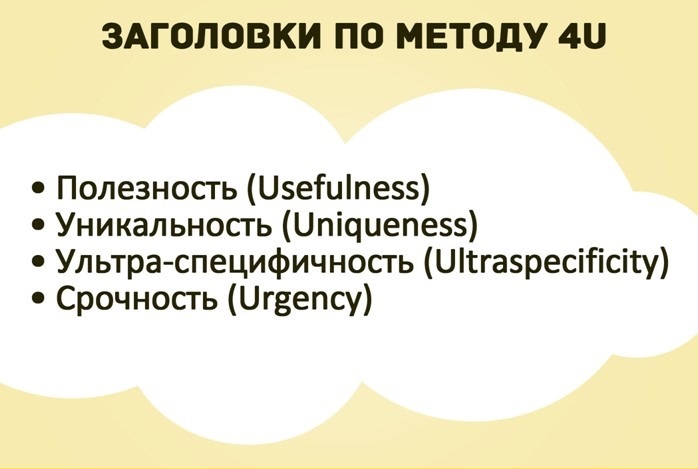
They can be long, ugly, at the same time perfectly convey the value of the proposal, rebuild from competitors and call the user to action.
What do utility, uniqueness, ultra-specificity and urgency mean? Let's look at a specific example from our practice:
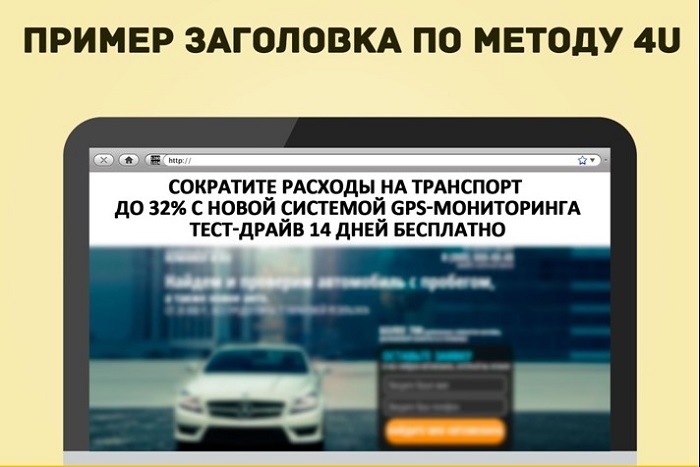
Utility is the main benefit. In this case - "Reduce transportation costs."
Uniqueness - with the help of which the client will benefit - “With the new GPS monitoring system”.
Ultra-specificity is a benefit in measurable units, how much your product increases profits or reduces costs. In this case - up to 32%.
Urgency - not necessarily a deadline. This is a time factor. After what time the client will get the result or, as in our example, an additional benefit in the form of a free test drive of the equipment for 14 days. Urgency can be rendered subtitled.
Signature to Lead Form
It stimulates to perform the target action, as a logical continuation of the offer in the title. And what exactly should the user do to contact the company? In the lead form (application form), you “cling” the visitor to something specific in return for his email, name and phone.
What they usually offer: sign up for a consultation, sign up for a measurement, register or just leave a request. By themselves, these things do not convert.
There is a so-called friction factor. Any, any significant efforts cause users to reject. They already meet you, leaving your phone and email. And here it is also not clear: “I will sign up for a consultation, and then what?”
Therefore, at least we give an explanation of what he will receive. And not just a consultation, but something concrete, tangible, like this:
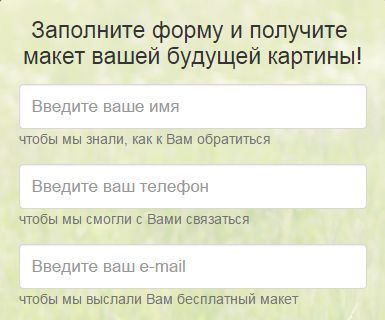
Pay attention to the signatures explaining the meaning of filling out each field. From the point of view of usability, this is not always justified, but here the reception is very "in the subject."
One more example:

Effective signature model - “Fill out a form to [benefit]”
A small trick in addition is social proof, like this:
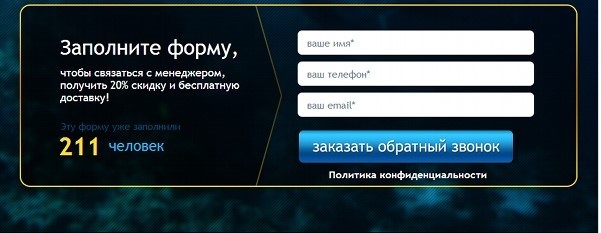
The main thing is that it corresponds to reality. Putting such things "from the bald" is not worth it - the deception will very quickly come up and it will hurt one place)
And here is the ideal, in our opinion, example of lead form:
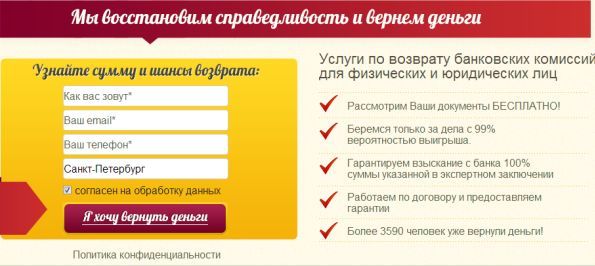
What well:
- Signed "find out the amount and chances of return" very accurately falls into the "pain" of the client;
- Next to the form of the list of advantages of the company (bullet). Make a reservation that bullets do not fit into every topic. All individually;
- The form itself is a value proposition, and without a title.
CTA button
The call to action is simple: it should symbolize the end result, for which the user leaves contacts.
Example:

In the mind of the user there should not be a gap “sent a request - waiting for a consultation - got the result”. Yes, in fact, the manager’s call is indispensable, and your potential client understands this. Just this way you eliminate friction. If you can not commit the action, the person will not commit it.
Therefore, the call-to-action ideally works as in the song of the group “Technology” - “Press the button, you will get the result”. And this is not a free consultation manager)
A pair of hacker chips.
First, under the button you can decipher what will happen after sending the application:
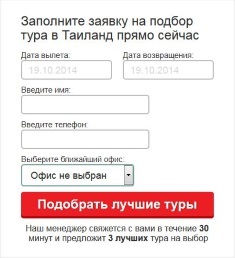
And secondly, to put an "alternative call":

True, this technique works more on pop-up windows, like CrazyEgg.
“Show me my heat map” / “No, thanks, I will leave everything as it is”
Refusing a targeted action, the user recognizes that he does not need analytics and an increase in conversion.
Here it is worth noting a cool chip that almost nobody uses in Runet. This is the signature on the first-person button: “Show me my heat map . ” The feature is already his and you are not asking the user, but he himself demands that you give it back.
How to increase return on conversion elements
First, a simple task:
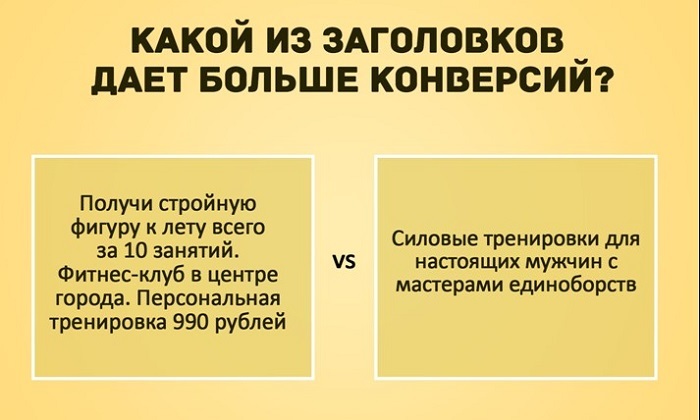
We recall the 4U technique ... Logically, the first one. It has more specifics, more benefits.
And now we look at the results:
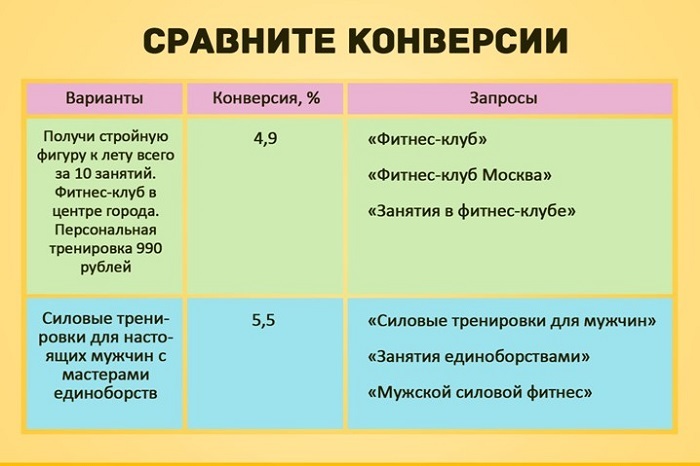
In the first version, general requests are “Fitness Club Moscow”, “Fitness Club Classes”, etc. The audience for them comes motley, girls and men, without specific motives. Maybe someone lose weight, and someone on the contrary to gain weight.
In the second case - extremely specific, "male" requests. Men want to do strength training. What, in fact, we offer them. Hence a higher conversion. Even without 4U.
Such a pun brings the sources of traffic to our harmonious picture of the world)
The main fakap landing pages is as follows:

Laughing with laughter, but in reality this is exactly what happens: both those who need a bath, and those who want to build a house from a bar, and those who need a solid concrete garage land on a page with the same sentence “Construction of houses and cottages ", eg.
As a solution - several landing pages for different types of requests. And if the company has dozens, hundreds of items of goods or services? Given that in the narrowest niche, you can “pull out” various kinds of needs and decision-making motives.
This is how we solved this problem with dynamic content. Case construction company.
Initial data - visitors come to the landing page with different selection criteria. They are few, but they differ significantly.
Someone is looking for the price ("Build a country house cheap"). Someone on the construction material ("Construction of houses from a bar"). And someone at the construction site ("Houses in the suburbs up to 30 km from Moscow Ring Road").
Conversion in the application - 1.9%.
Of course, the other factors are also important, but when the user enters the query “Construction of houses from a bar”, we assume that for him this is the main selection criterion. A certain initial filter - it practically does not pay attention to other options.
The task is to give him the appropriate offer. Of course, it should be among the company's services: the offer is not for the sake of "zamanuhi", but to personalize the choice.
You should not be guided by the logic of advertisements in Yandex Direct and repeat the value proposition 1 to 1 to the request. There are many typical queries that speak of one need. For example, the choice for the price - "Build a country house cheap", "How much will build a house from scratch", "Calculating the cost of a house calculator."
In the Yagla system , we group them and create one sentence. In this case, it is 745 phrases and 66 groups.
Screenshot from the table of changes:
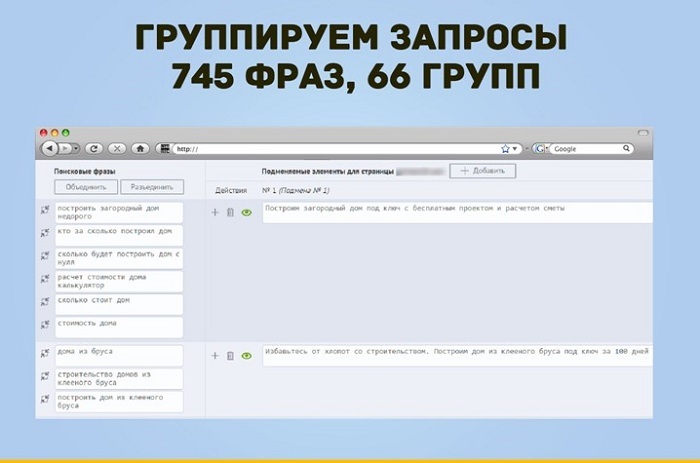
On the same page, the title adapts to the user's need. In this case, the process does not occur on the machine. It is necessary, nevertheless, "turn on the brain" and come up with offers. Yagla only does what you specify in the substitution editor.
What was done
Together with the original heading “Construction of houses and cottages in Moscow and the Moscow region”, we put in a / b testing substitutable headers with personalized offers.
For example:
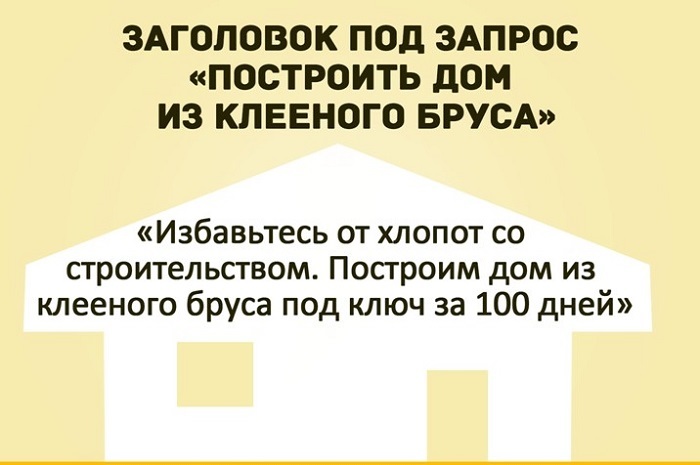
Please note: in the heading we are doing not just compliance with the request, but a profitable offer - we promise to save the client from the hassle of construction, to do turnkey work. Plus - a specific period, 100 days.
And we further strengthen the proposal in the application form (the second substitute element):
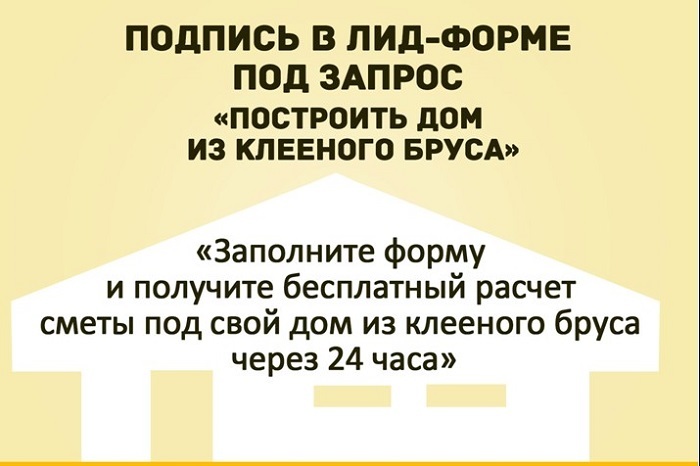
As a result of setting up and testing the substitution after 2 months, the conversion in the request increased 3.5 times, from 1.9 to 6.7%.
Important points
1) Determine the needs of the target audience for requests;
2) Create personalized offers (offers) for each need;
3) We adjust offers for requests from the context (Yandex Direct & Google AdWords) with the help of dynamic content.
Share in the comments how useful this information is and what you think about it.
Source: https://habr.com/ru/post/295876/
All Articles